About six months ago, Dan Shusett from Tricolate introduced us to the idea of Wet Weiss Distribution — that is, using a Weiss distribution tool to stir wet coffee grounds during brewing. It turns out that Wet Weiss Distribution is surprisingly effective — not just in no-bypass brewers like the Tricolate, but also in conventional filter brewers like the V60.
Traditional stirring methods, with a spoon or spatula, can increase extraction, at the cost of slowing down the brew time. In extreme cases this leads to choking and channelling, creating a bitter, ashy brew.
On the other hand, using the fine needles of a Weiss distribution tool to stir the bloom or the slurry in your brewer can increase extraction without causing the brew time to slow down. Wet Weiss can therefore give you increased extraction without an increased risk of channelling. So if you haven’t already adopted this technique for your filter coffee, then you should probably give it a try.
Naturally, though, our experiments didn’t end there. The Weiss Distribution Technique was, after all, invented for espresso — why wouldn’t Wet Weiss work for espresso as well?
The answer is that it doesn’t. In fact, it was a disaster. First of all, there are some practical difficulties: For example, have you ever tried tamping wet coffee? It isn’t easy! But even when we solved these problems, we found that the Wet Weiss technique made it more or less impossible to brew a tasty espresso.
However, using Wet Weiss in espresso did raise some interesting questions about what happens inside an espresso puck when we tamp, and how preinfusion and ‘blooming’ work in espresso. It also suggests one reason why high humidity conditions can cause such problems for baristas.
Wet Weiss and Jamming
As with all our best and wildest experiments, our investigation of Wet Weiss for espresso began with a conversation with multidisciplinary industrial scientist Professor Abbott. He suggested that adding some water before tamping might allow us to pack the bed of coffee more tightly together.
Back when we were researching our Advanced Espresso course, we were exploring the science of ‘jamming’ and how it relates to coffee. Jamming explains how powders — like ground coffee — can form structures that resist forces on them — like tamping.
Loose powders can flow, in a similar way to a liquid. Under certain conditions, the particles in a powder can form structures, such as arches, that ‘jam’, or block the flow.
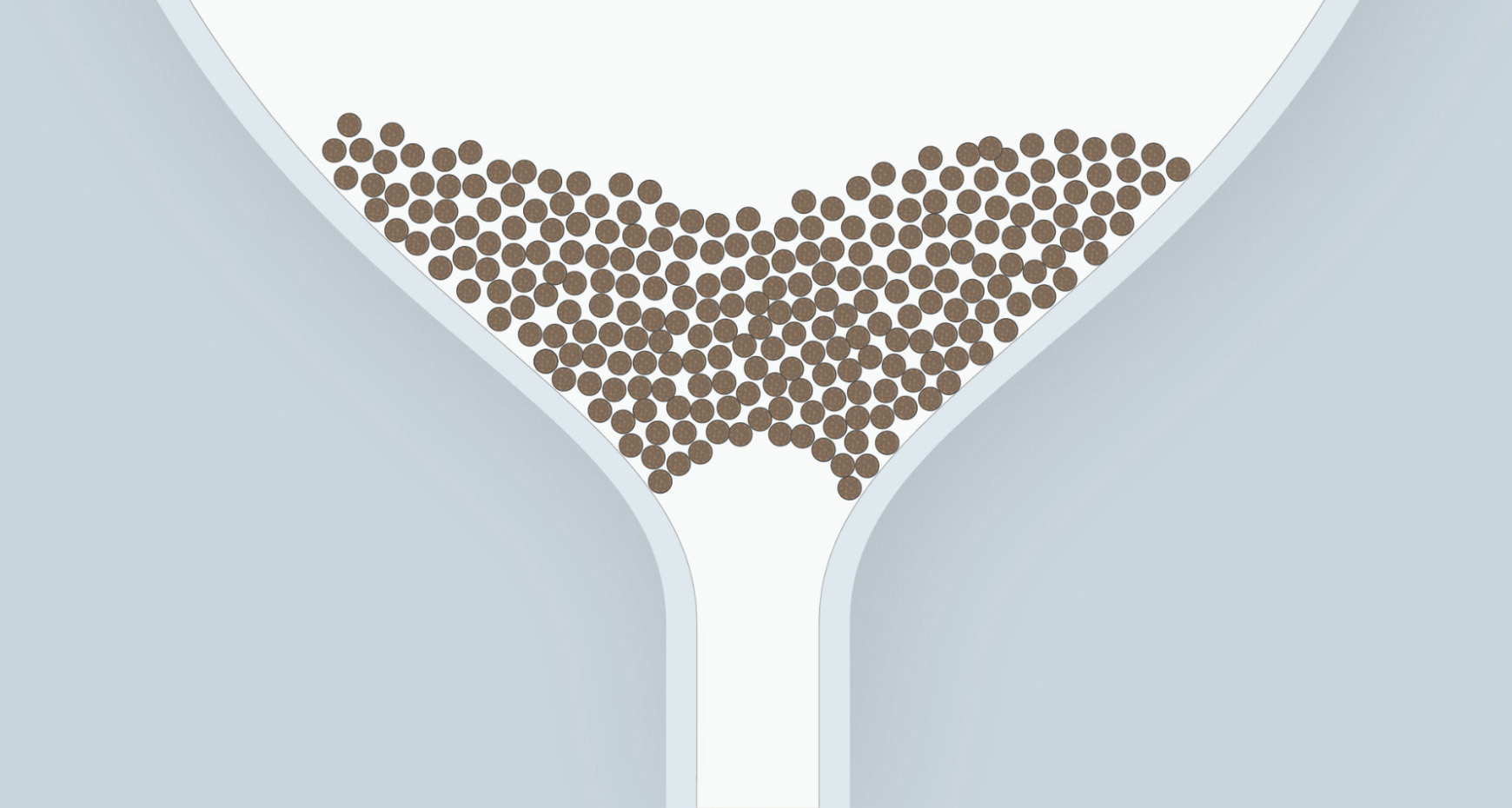 Sand particles in an hourglass can spontaneously form an arch structure, causing the flow of sand through the hourglass to jam.
Sand particles in an hourglass can spontaneously form an arch structure, causing the flow of sand through the hourglass to jam.
The same principle limits how tightly coffee can pack together in an espresso puck. When you tamp the ground coffee, the puck compresses up to the point that the particles connect and become jammed. After that, tamping harder has no further effect on the structure of the puck.
In many situations, adding water helps overcome jamming. A small amount of water can create ‘capillary bridges’ and cause particles to stick together — as anyone who has tried to pour damp salt out of a shaker knows. On the other hand, if you add a larger amount of water — when mixing cement, for example — it acts as a plasticiser. A plasticiser stops particles from sticking together, and allows them to move more freely.
In coffee, moisture also has an additional effect: it makes coffee’s cell walls more flexible (Mateus et al 2007), allowing the particles to deform more easily. This would make it easier for the tamping force to break up a jam in the ground coffee.
Between these two effects, we thought there was a good chance that adding some moisture before tamping might allow us to create a super-dense coffee puck. Furthermore, we wondered if creating a super-dense puck this way — if it turned out to be possible — would reduce channelling or boost extraction.
The Wet Tamping Challenge
The first problem to overcome was how to tamp wet coffee without it sticking to the puck. The most effective method we found was to use cling film on top of the wet coffee.
We began by mixing ground coffee with boiling water in a cup, using the Comb WDT tool to ensure the water and coffee were fully mixed. We scooped the wet coffee into a portafilter basket, stirred with the Comb again to ensure even distribution, then laid a layer of cling film on top before tamping.
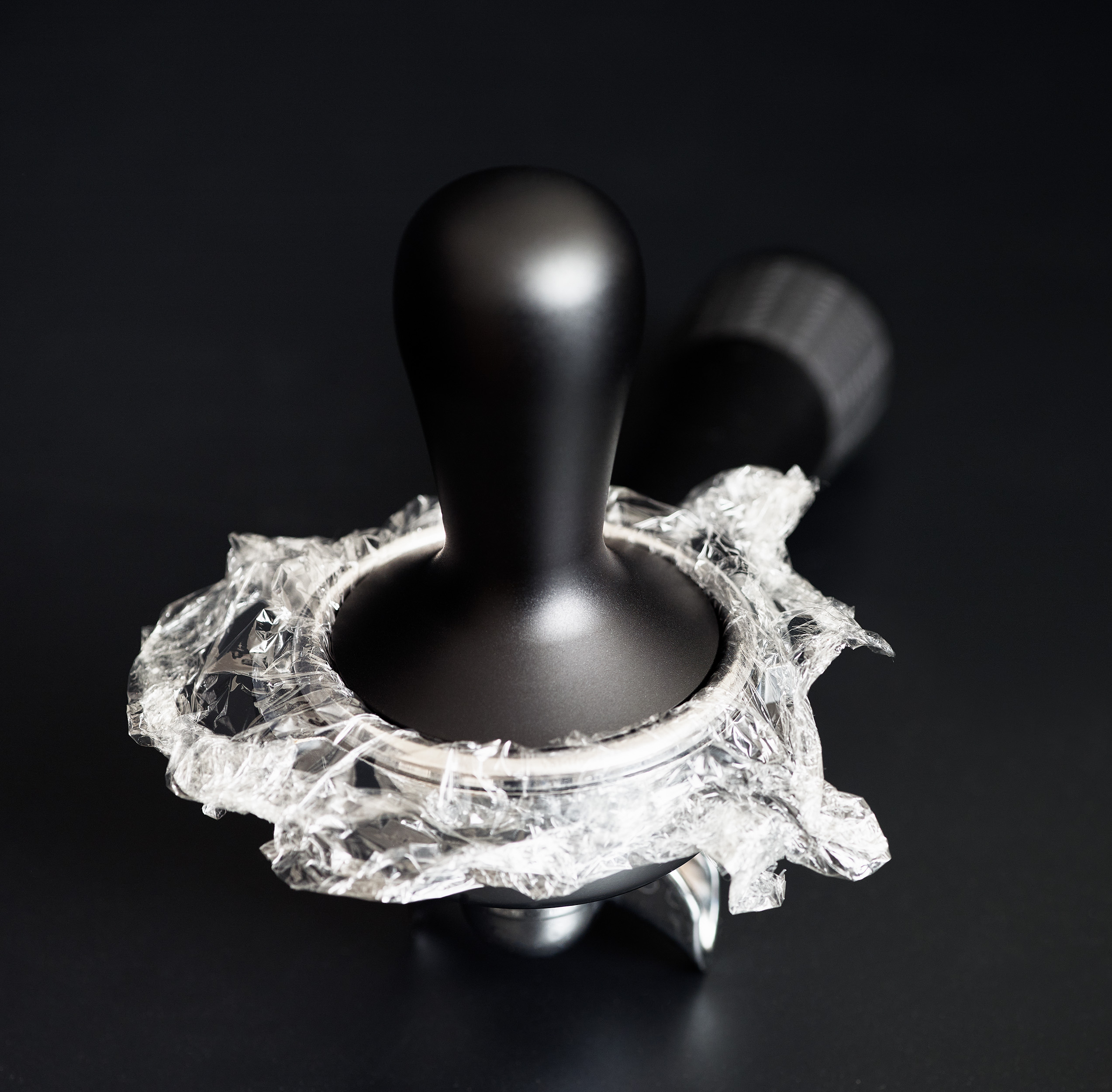 A layer of cling film is essential for tamping wet coffee
A layer of cling film is essential for tamping wet coffee
Once the coffee was tamped, we could gently peel off the clingfilm, leaving a perfectly tamped, wet puck.
With this problem solved, we started pulling shots, and almost immediately realised that wet tamping was not going to work the way we had hoped. The shots simply flew through the machine, no matter how finely ground the coffee was. We were making the espressos using a well-aligned EK43, with the burrs touching, and still getting incredibly quick shot times.
The extraction was similarly dismal — even when making espressos with yields of up to 60 grams, the highest extraction we were able to achieve was about 20% lower than that of a typical espresso brewed at a 1:2 ratio. This is even more striking when you consider the extended contact time between water and coffee while making these espressos, thanks to the time taken to stir the wet coffee. Whatever effect water was having on the puck prep, it was clearly not what we had hoped.
Inside the Puck
To see if adding water was having any effect on the structure of the puck, we started by measuring the puck height after extraction, using the same dose and grind size for wet and dry tamping. The wet-tamped and dry-tamped pucks were the same height, to within a tenth of a millimetre. This clearly indicates that the added moisture wasn’t having much effect on the overall packing density.
We also cut the two pucks open, to see if we could see any difference in the structure of coffee inside the puck. At first glance, no major differences were apparent between the two pucks.
Left: a conventional, dry-tamped puck. Right: a wet-tamped puck
Zooming in on the pictures, however, revealed a possible difference. The dry-tamped puck looks muddier, as if it had retained more fines. The wet-tamped puck, meanwhile, appeared to have a more open texture.
Left: the muddy texture inside the dry-tamped puck. Right: the looser texture of the wet-tamped puck
The act of cutting the puck inevitably disturbs the structure, so we’re cautious about reading too much into a slight visual difference like this by itself. To see if there was any difference between the particles retained in each puck, we ran a particle size analysis. We took a thin slice across the centre of each puck, dried the particles, and separated them out on a lightbox. We analysed the size distribution across four separate images.
 Analysing the particle size distribution
Analysing the particle size distribution
We found that, considered on the area or volume basis, the wet-tamped coffee had a slightly smaller average particle size than the dry-tamped coffee. The difference was slight but statistically significant.
| Diameter basis | Wet | Dry |
| Number (D[1,0]) | 0.224 | 0.231 |
| Surface area (D[2,1]) | 0.366 | 0.377 |
| Volume (D[3,2]) | 0.487 | 0.498 |
Particle size diameter of wet and dry-tamped pucks. The surface area and volume basis measurements were significantly different (T-test, p<0.05)
Since this test is only based on photos of the same sample of coffee, it can only confirm the difference between these two samples — it would take a lot more analysis to extend this to wet and dry-tamped coffee in general. It does, however, contradict the idea that the dry puck is retaining more fines, as the images initially suggested.
The texture difference we noticed could just be an artefact, an apparent difference caused by the way the coffee was cut — or it could be something else entirely. When we cut open the pucks, we did notice that the particles in the dry-tamped puck were stuck together much more strongly than in the wet-tamped puck. However, there’s no way to be sure if this relates to differences in the structures formed during tamping, or due to the unextracted material left behind.
Barriers to Flow
So if there isn’t a clear structural difference between the pucks, why is the flow rate so different? Two possible candidates are the hydrophobic nature of dry coffee, and the gases trapped inside the particles.
Dry coffee naturally resists the flow of water because it is hydrophobic, compared with wet coffee. This is similar to what happens when you water a completely dry pot plant — at first the water pools on top of the soil, or bypasses the soil entirely. The soil can only absorb the remaining water when it is already slightly damp.
The gases trapped inside dry coffee also seem to block the flow of water through the puck. This is why freshly roasted coffee needs a coarser grind than old coffee — it contains more trapped gases, which limits the flow of the espresso (although the story is a little different when the coffee is very fresh).
One clue to which of these factors is more important came when we repeated the wet tamping experiment, but using cold water to wet the coffee grounds initially. In this case, the difference in shot time was much lower. If the difference in shot time was only due to the dry coffee being hydrophobic, then we would expect cold water to have a similar effect.
On the other hand, the degassing rate is linked to temperature (Smrke et al 2017) and hot water seems to cause coffee grounds to release trapped gases more quickly than cold water does. Using cold water to pre-wet the grounds thereby reduces the effect on shot time, because the coffee has degassed less before brewing. However, the espresso made this way still has a noticeably ‘stale’ aroma, which we assume is due to volatile aromas being lost when wetting the coffee.
On a whim, we also tried using steam to pre-wet the coffee grounds. In this case, the aromas coming off the coffee grounds during the pre-wet stage — aromas that would be missing from the espresso — were very potent. The resulting espresso gushed out in a matter of seconds, and had virtually no crema at all.
All in all, it seems most likely that the effect of degassing is what caused this experiment to fail. It also suggests one reason why preinfusion is so useful in improving the quality of espresso. In espressos made with pre-infusion (or the more extreme ‘blooming’ espresso) degassing allows a faster flow, and hence, a finer grind — without aromas being lost to the atmosphere as easily as wetting the grinds in the open air.
Humidity in Espresso
The effect of humidity can be seen in coffee stored under humid conditions. James Hoffmann explored the effect of humidity on filter brewing in a video exploring earlier experiments by Hamad Rahsid, and found that coffee stored at high humidity had a smaller bloom and a much faster flow rate in a V60 than coffee stored in dry conditions. Similarly, coffee that is ‘quenched’ (cooled) with water at the end of the roasting process, which has a higher moisture content, degasses faster than air-cooled coffee (Baggenstoss et al 2007).
Robert McKeon Aloe expanded on this idea for espresso, and found that humidified coffee needed a much finer grind setting to achieve reasonable shot times, and that the resulting shots had much less crema. All of this points to degassing as being an important part of the effect of humidity on espresso.
Humid conditions could cause faster degassing by making the coffee structure more flexible, allowing gases to escape, explains Professor Abbot, saying: “I think the humidity is making the particle walls more mobile (i.e. lowering the glass transition temperature) so the diffusion rate of CO2 increases.”
Other factors play a part in the effect of humidity, too: humid beans are less brittle, and therefore produce less fines when they are ground (Baggenstoss et al 2008). This means that humid beans must be ground at a finer setting to achieve the same shot time. Our experiments show, however, that grind size is not the only factor.
As to how to pack your puck more tightly? Well, we’re still working on it. There are a multitude of contradictory factors that affect jamming, and unpicking the effects of each is very difficult. “The science of how dry particles behave is lamentable,” Professor Abbott explains. “This means that what happens when you dry tamp is a whole set of complicated unknowns and there aren’t any good ways to measure those unknowns anyway.” Professor Abbott did, however, come up with a new potential technique to better understand tamping which we’re hoping to explore soon — so watch this space.
There are still plenty of factors to explore in our attempt to create the perfectly tamped bed of coffee — but we can be fairly clear that, as far as espresso goes, it’s best to keep your powder dry.
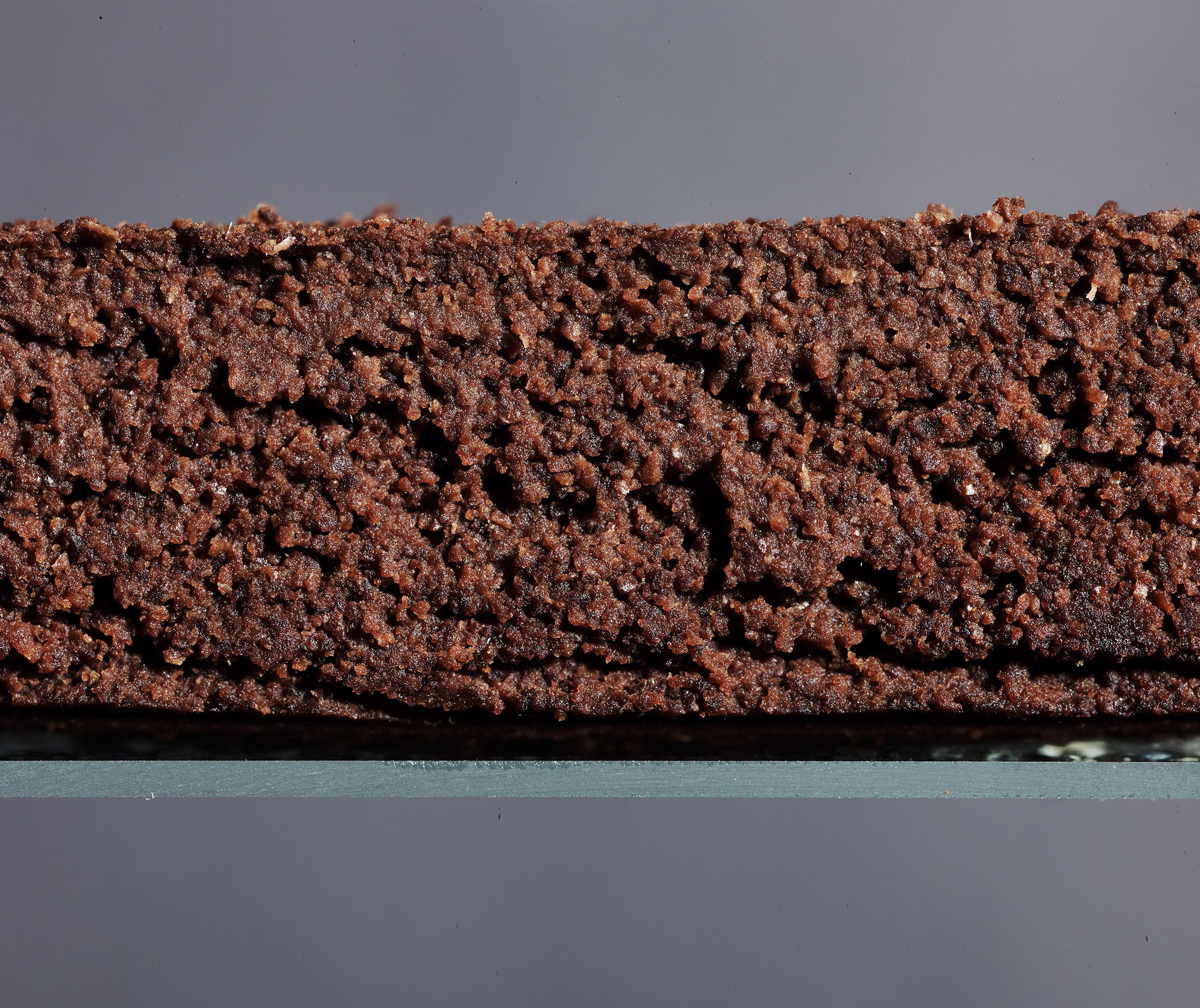
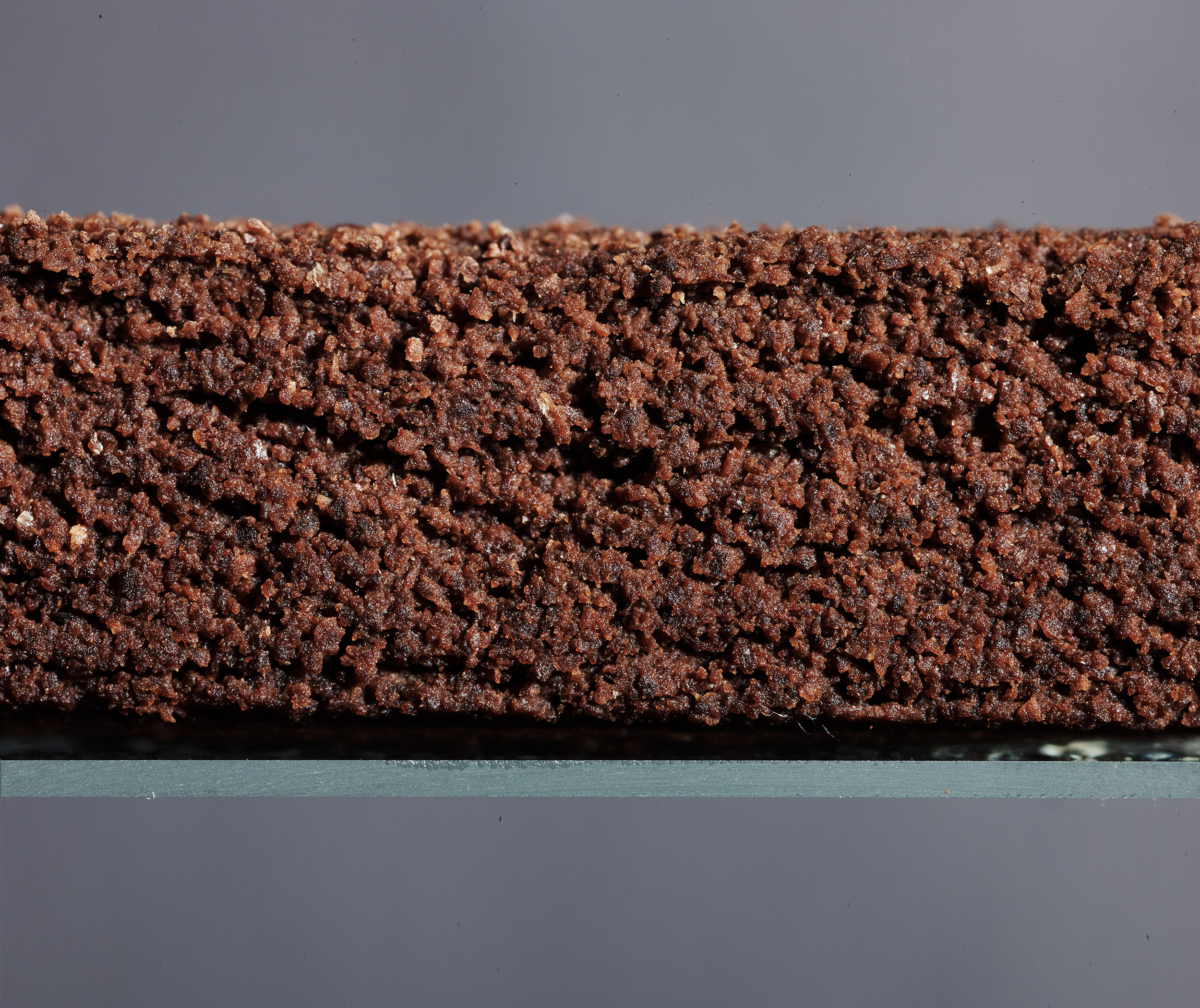
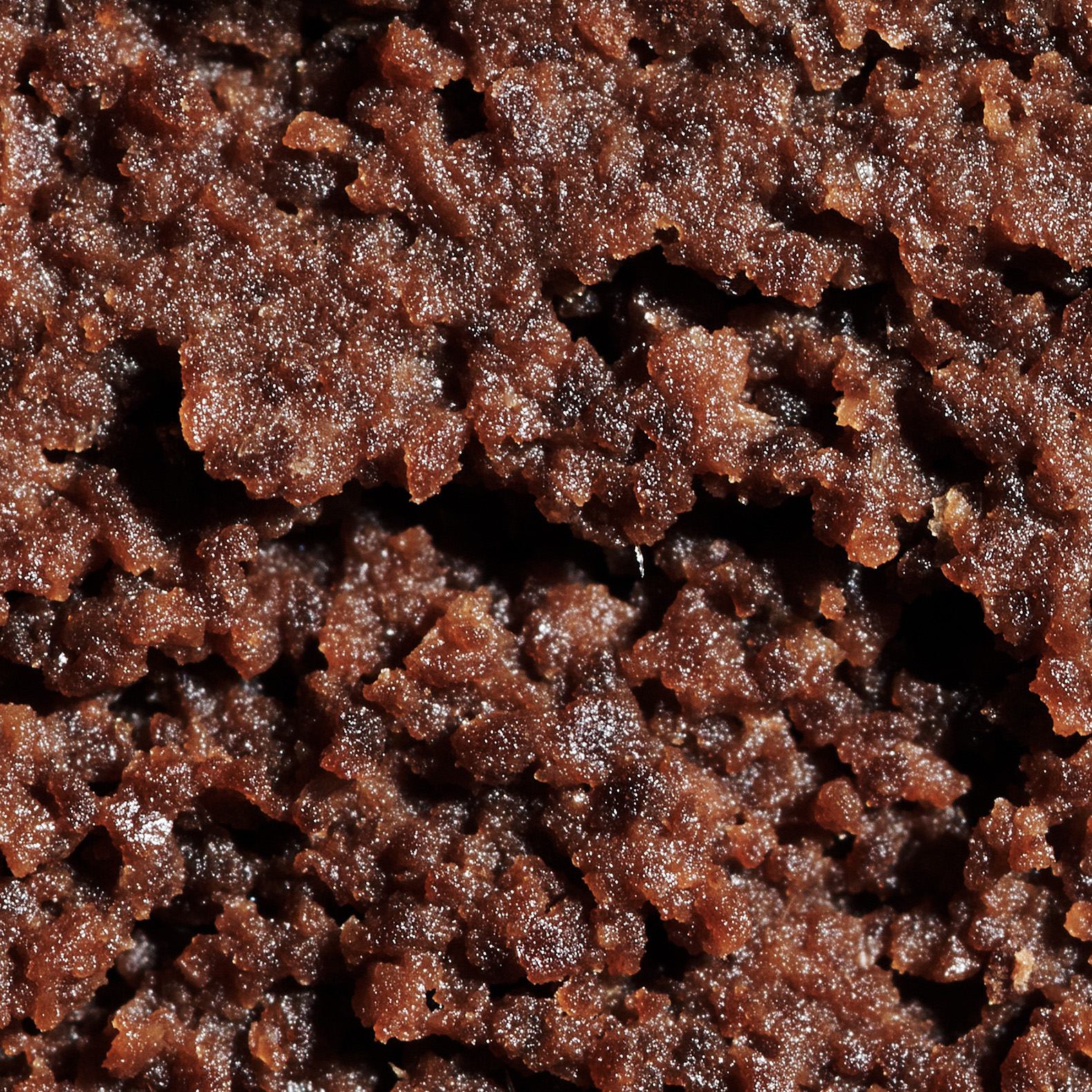
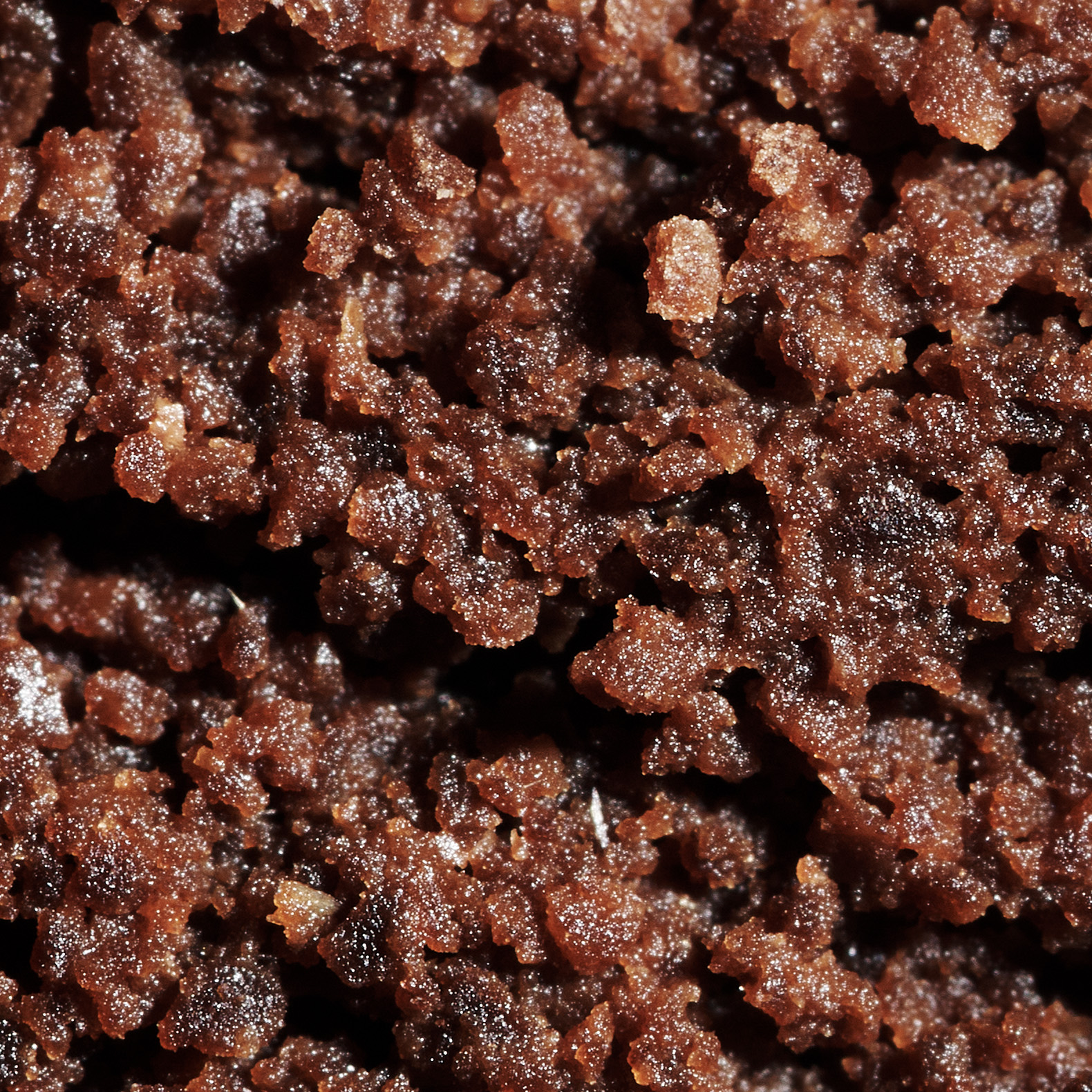




0 Comments